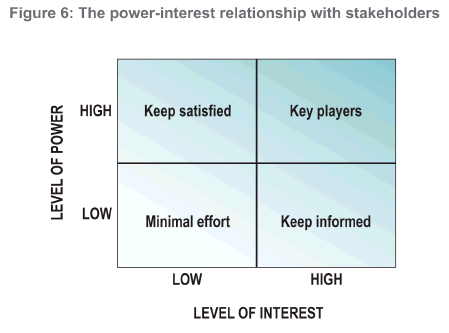Stakeholder Analysis and Matrices
From DTU ProjectLab
(Difference between revisions)
(→References) |
(→Stakeholder Analysis) |
||
| Line 11: | Line 11: | ||
=Stakeholder Analysis= | =Stakeholder Analysis= | ||
| + | |||
| + | [[File:6830-pf-8.gif]] | ||
==Benefits== | ==Benefits== | ||
==Challenges and Uncertainty== | ==Challenges and Uncertainty== | ||
| − | |||
=Stakeholder Matrix= | =Stakeholder Matrix= | ||
Revision as of 14:07, 12 September 2015
Stakeholders are referred to as actors (persons or organizations) with a vested interest in the decision or policy that is being promoted. Stakeholder analysis is the method or process used to identify these actors or key individuals/groups that will have an affect on a project, and how to win them over. Stakeholder analysis allows policy and/or decision makers to interact more effectively with key stakeholders; detect and act to prevent potential misunderstandings about and/or opposition to the policy or program; and increase support for a given policy or program.
Contents |
Background
Process
Stakeholder Analysis
Benefits
Challenges and Uncertainty
Stakeholder Matrix
How to make a Stakeholder Analysis Matrix
Benefits
Challenges and Uncertainty
Conclusion
References
Further Readings
Cite error:
<ref> tags exist, but no <references/> tag was found
